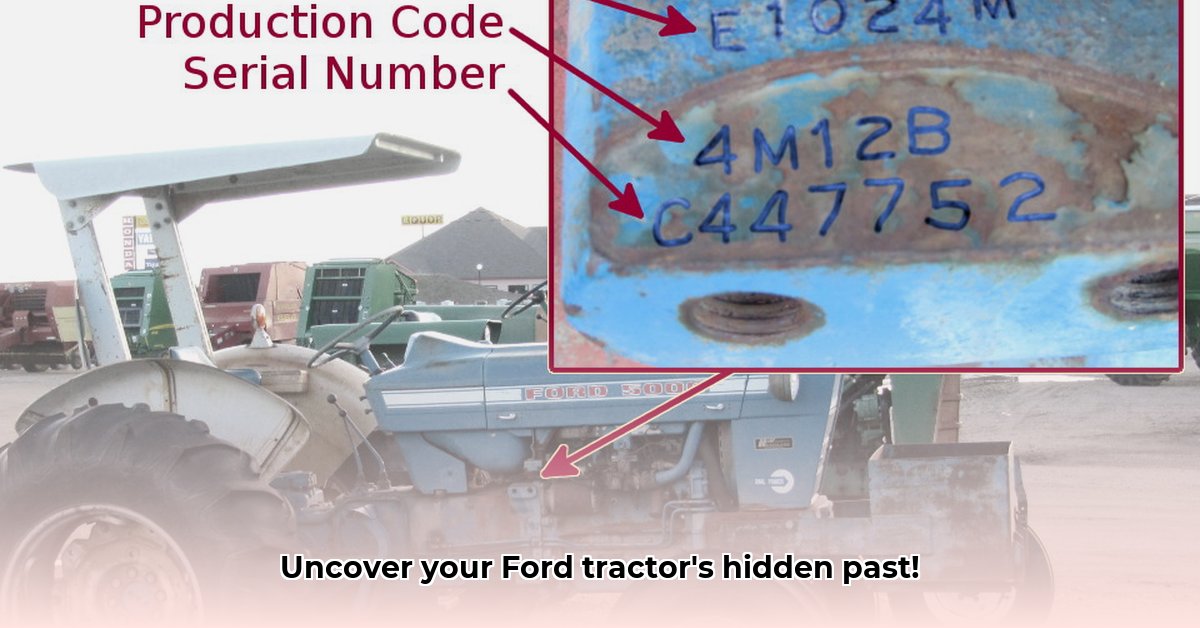
Ford Tractor Serial Number Codes: Decoding Your Tractor's Past
The seemingly random numbers stamped on your Ford tractor's serial number plate hold a wealth of information about its history. This guide will walk you through decoding this vital identifier, revealing insights into your tractor's model, manufacturing date, and even its place in Ford's agricultural legacy. Whether you're a seasoned mechanic or a curious owner, this guide will empower you to unlock your tractor's story. For more detailed information on specific models, check out this helpful resource: Ford Tractor Serial Number Decoding.
Early Ford Tractors: Uncovering Approximate Manufacturing Dates
Iconic models like the 9N, 2N, and 8N had serial numbers stamped directly onto the engine block. While this provides a general timeframe for manufacture, it isn't a precise science. Manufacturing variations, delays, and even some unique quirks in early stamping practices (like using a lowercase "b" for a "6" or an upside-down "9") mean you'll get a broader timeframe rather than an exact date. This is important to remember; an early Ford serial number only points to a specific period, not a specific day.
Why the imprecision? "The early production processes were less standardized," explains Dr. Amelia Hernandez, Agricultural Historian at the National Museum of Farm Machinery. "Multiple stages and varying component production lead to a lag between individual part manufacture and final tractor assembly."
Did you know that casting dates on other tractor parts can offer additional clues? These often include a letter (month), and numbers (day and year). Combining these with the serial number helps refine your estimate, but achieving pinpoint accuracy is unlikely with early models.
Later Models: A More Precise Picture
Later Ford tractors (2000, 3000, 4000 series and beyond) provide more complete information. Their serial numbers, typically found on the transmission housing, are more structured. These numbers usually consist of several sections, each providing specific details. You might find information about the model, year, month, day, production shift, and even the factory where it was built!
"The increased precision in later models reflects advancements in manufacturing efficiency and record-keeping," adds Dr. Hernandez. "This allowed for a more streamlined and documented production process, leading to greater accuracy in serial number information."
Decoding Your Tractor's Serial Number: A Step-by-Step Guide
Let’s decipher those numbers. This guide focuses on the multi-part serial numbers typical of later model Ford tractors.
Locate the Serial Number: The first step is finding the serial number plate. It’s often on the transmission housing, but its precise location varies by model. Thorough cleaning with a suitable brush and degreaser might be necessary to remove dirt and corrosion that obscures the numbers. A flashlight might prove useful.
Divide and Conquer: Carefully record the entire serial number. Break it into its component sections. Each section holds a piece of the puzzle.
Find Your Chart: This is crucial. Find a decoding chart specific to your tractor's model and year. Online Ford tractor forums, owners' manuals, and specialized websites are excellent resources.
The Translation: Using your chart, translate each section of the serial number. This will usually reveal the year, month, day of manufacture, and possibly the production plant.
Verification: Check your decoded information against other available records, such as your owner’s manual or any accompanying documentation from previous owners. This helps confirm accuracy and resolve any discrepancies.
Troubleshooting Common Issues
Even with careful work, you might encounter challenges.
Obscured Numbers: Corrosion, paint, and dirt can hide parts of the serial number. Gentle cleaning with appropriate tools is essential. Remember to always exercise extreme caution to avoid damaging the cast metal.
Missing Numbers: Damage to the tractor could mean some numbers are irretrievably lost. While complete decoding is impossible in this case, you can still gather partial information.
Variations: Manufacturing variations are expected. Minor differences in serial number formats are normal, adding to the tractor's unique character.
Why Bother? The Value of Knowing Your Tractor's History
Knowing your Ford tractor's build date is invaluable for several reasons:
- Parts Sourcing: It greatly simplifies finding the correct parts, especially for older models or specific components.
- Valuation: Accurate dating significantly impacts the determination of a tractor's value, particularly for collectors.
- Historical Significance: Understanding your tractor’s place in Ford’s history connects you to a rich agricultural legacy.
By carefully following these steps and utilizing the available resources, you can unlock the fascinating story behind your Ford tractor's serial number, gaining valuable insights into its unique history and heritage.